Table of Contents
Purple Tang: A Quick Summary
Purple tangs are tropical fish known for their bright purple color and distinctive, oval-shaped bodies. They are native to the coral reefs of the Red Sea and Indian Ocean and are popular in the aquarium trade for their active, playful behavior.
Purple Tang Overview
Purple tang is popularly known for being one of the gorgeous fish available for a saltwater aquarium for your home. The purple tang is lengthy and has a round-shaped body. In addition, the large dorsal and anal fins of these fish provide them with a circular impression. The size of purple tang normally varies from 8-10 inches.
In this article, you would get complete care for your purple tang. In addition, you would learn about their suggested tank mates, best diet, adequate size of the tank, and even how to explore the reproducing system.
| Information Chart | Purple Tang |
| Scientific Name: | Zebrasoma xanthurum |
| Family: | Acanthuridae |
| Care Level: | Moderate |
| Temperament: | Aggressive |
| Color: | Dark blue to purple |
| Lifespan: | 10 years or longer |
| Size: | 8 to 10 inches |
| Diet: | Herbivore |
| Minimum Tank Size: | 100 gallons |
| Temperature: | 74°F – 82°F (24°C – 28°C) |
| WaterConditions: | pH 8.1 – 8.48 – 12° dKH |
| Tank Mate Compatibility | Clownfish and large angel |
Purple Tang Appearance

From the name of purple tang, you would be able to recognize that these fish generally range from dark blue to purple, with some darker shade at the middle portion of their body. They have a disc-shaped appearance with bright yellowtail.
Purple tang might also exhibit black spots or streaks, especially somewhere on the face and along with the lighter portions of their body. In expansion, you would see the glossy yellow tail fins of the purple tangs and yellow accents, have lustrous tips on their pectoral fins.
Lifespan Of Purple Tang
The typical life span of a purple tang is 10 years or more. But the poor water movement and an insufficient environment can curtail the lifespan of your purple tang considerably. Therefore, you are required to provide your top-notch fish care, good water quality, and stress-loose surroundings to assist them to live a long life with comfort.
Purple Tang Size
The typical purple tang typically grows up to 8 inches on the lower end and 10 inches for larger specimens. Since these fish have a larger size, you are required to be sure that you keep your purple tang in the right tank to live a safe and prosperous life.
Natural Habitat And Origin
Purple tangs are commonly known a reef fish, and you would find these fish generally in the Red Sea. However, purple tangs could also be seen in the western Indian Ocean, Gulf of Aden, the Persian Gulf, and the Arabian Sea.
These fish like to inhabit separately. So if you think to keep purple tangs in pairs or a large group, you must find an area with enough space.
If you keep these fish in home aquariums, these purple tangs would require large tanks because of their grown-up length. A tank of at least 100 to 125 gallons would be necessary to give leading care to your purple tang and assure that your fish is safe and happy.
Purple tangs like to roam around the predator tank with enthusiasm, and they are extremely active fish. Therefore, purple tang appreciates having a lot of unrestricted areas in which they would be able to swim freely. Furthermore, the purple range enjoys a nice percentage of light.
Purple Tang Care & Tank Set-Up
Purple Tang Tank Size And Specifications
Purple tangs are normally aggressive and large. Therefore, it is a very crucial factor to consider the size of the tank.
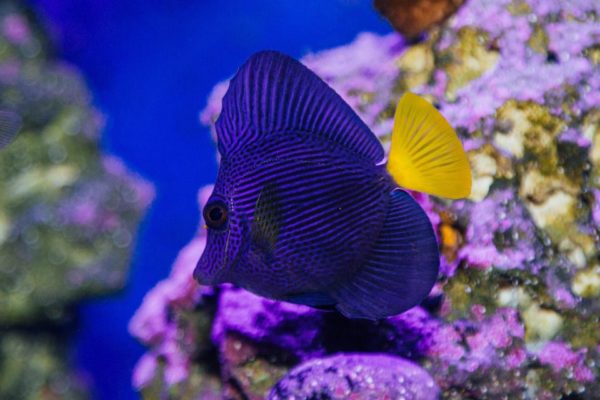
Optimum Tank Size For Purple Tang
The recommended tank size for purple tang is 100 gallons (380 l). Since these fish are aggressive and large, a tank of at least 100 gallons or very large tanks would be better. Purple tang also loves to roam around the tank and swim with energy. Hence, a large tank would be better for your purple tang for their comfort.
Tank Shape For Purple Tang
A large tank with a cubical shape would be great for your purple tang as it would not create any problem for your fish in roaming around the tank, and your purple tang would be able to swim with enthusiasm.
Filter Type
Seawater is always restored, but a similar impact does not arise in a tight compartment. Harmful trash could amass in the tank if the filter is not always shifted adequately. Natural filters are utilized to be kept under extremely glossy light until some dimly lit areas are given.
Substrate
You are required to be very convinced there is a smooth and soft substrate on the floor of the tank. This is because when purple tang becomes aggressive, they start rooting around and swirl through the substrate, but there is fear for them to get cut at the time of doing this. Therefore, you are required to be very careful to select a soft substrate.
How Many Purple Tang In 100 Gallon Tank?
As already discussed, purple tang becomes extremely aggressive sometimes, and they generally prefer to live separately and alone. Also, they are very large and like to roam around the tank and swim with enthusiasm. Therefore, a tank of at least 100 gallons would be suitable for only one purple tang.
Water Parameters For Purple Tang
You need to make certain that your water parameters are inside the correct range. It would affect the lifespan of your purple tang and could make sure their fitness over time.
Water Temperature
The ideal water temperature for purple tang is between 74°F – 82°F (24°C – 28°C).
Ph Level
The perfect water pH level for purple tang is 8.1 – 8.4.
Water Hardness
Normally, the hardness of water for your purple tang would be something 420 ppm. You are required to examine the hardness levels of water at least twice a week.
Purple Tang Tank Landscape
The way you set up the tank for your purple tang would considerably affect their enrichment and difficult grades over time. Hence, if you wish your purple tang to remain healthy, comfortable, safe, the following are some areas on which you are required to pay tight attention:
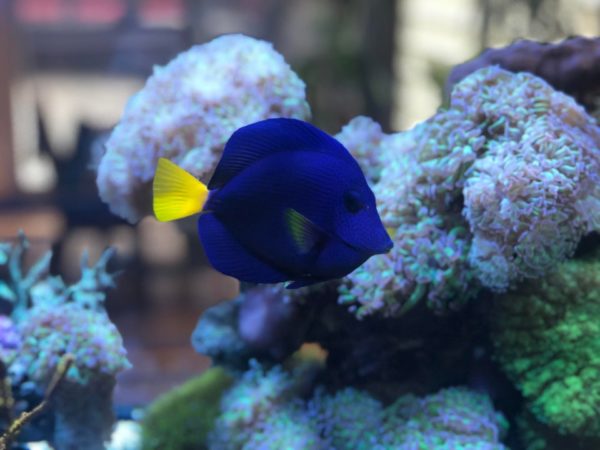
- Hiding places
- Plants
- Substrate
Decorations For Purple Tang Tanks
Decorating the tank of your purple tang could be a challenging task. Oscars are enormous fishes, strong enough to push small items and uproot plants in their tank. Generally, you would find the decorated tanks for Oscars. In addition, you would see huge gravel or driftwood in tanks of Oscars as a centerpiece. You could also place a live rock to create a reef environment. Live rocks also help make a hiding place for them.
But you are always required to keep in mind that if you decorate the tank of your purple tang too much, this could reduce the swimming space for your fish. Hence, the purple tang would face various difficulties, and even they could feel unhappy.
Lighting For Purple Tang Tanks
When it comes to lighting, you can keep your purple tangs in ordinary lighting conditions in the tank, but you would also be able to keep them under extremely glossy light.
Feeding Purple Tang
All the purple tangs are herbivores. They would always have meaty food, but their food must be made up primarily of seaweed, greens, and algae. Purple tang would always feed on its favorite meaty foods, which is nothing but algae that accumulate in the tank, but it is normally not sufficient to account for their whole nourishment. You should always add some protein-rich foods to their diet.
Rather, you could put warmed or dried algae in the fish tank. Aquatic seaweed would also be a great alternative for the offering. You can tie the seaweed to gravel or scrape it to their tank so that your purple tang would be able to feed additional sincerely. Other varieties of vegetable matter or fritter diets would also be beneficial in enhancing the diet of purple tang and assuring it is obtaining adequate nutrients.
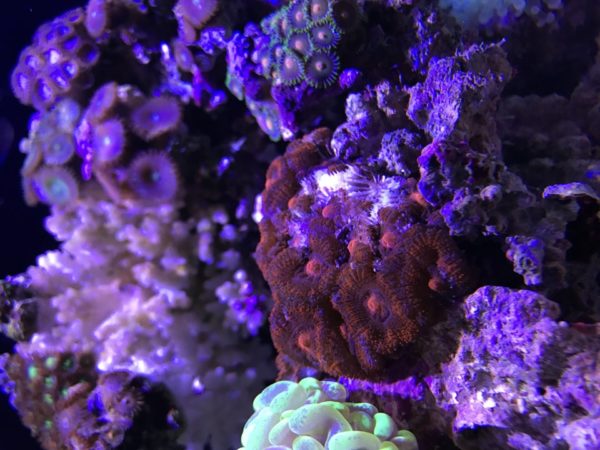
Many fishkeepers always recommend feeding your purple tang at least thrice a week. It is also advised to provide algae and a huge chunk of seaweed or algae that would keep your purple tang occupied for an assorted time, as it mimes their biological feeding manner and likes to graze on algae.
Best Diet For Purple Tang
- Music shrimp
- Japanese Nori
- Frozen brine
- Fish and eggs
- Flake foods
- Sea-weed
- Marine algae
Sometimes, live foods like gravel with some macro and micro-organisms could also be added to your fish tank. It would justify your purple tang for becoming glad in its atmosphere. Lettuce, spinach, Frozen zucchini, and broccoli would help you to make their nourishment extremely complete.
How Often Should You Feed Purple Tang?
Purple Tang should typically be fed every week at least three times. You can feed them with seaweed, greens, and algae. Most importantly, you should avoid overfeeding as it could result in serious illness for your purple tang.
You would already know that overfeeding your purple tang could be dangerous because purple tang could face problems with the digestive system. Hence, it is always recommended to avoid overfeeding your purple tang.
Purple Tang Behaviour And Temperament
Purple tangs tend to be non-contentious towards other species of saltwater fish; these fish species could be somewhat territorial around other tangs or, in reality, around any other fishes who have an identical length and shape of the body.
Because of this purpose, normally, it is suggested that these fish are required to be kept separate and sheltered without any other fish with an identical impression. However, in unusual circumstances, if the aquarium is big sufficient and the purple range does not exhibit an excessively contentious attitude, sometimes you can keep your purple tang with other tangs.
In such situations, fish keepers might prefer to introduce every fish species at the equivalent moment only to prevent territorial conflicts. Despite their relatively contentious behavior, tang species commonly work nicely in a coral reefs environment. Therefore, they are considered to be consistent with corals or leeches.
Are Purple Tang Lone Or Societal In Nature?
Purple tangs are lone in nature because they are extremely aggressive and large. Therefore, purple tang likes to live separately. However, if you keep them with other fish species, especially identical, they would become contentious.
Purple Tang Tank Mates
Ideal Purple Tang Tank Mates
The following is the list of the ideal tank makes for your purple tang:
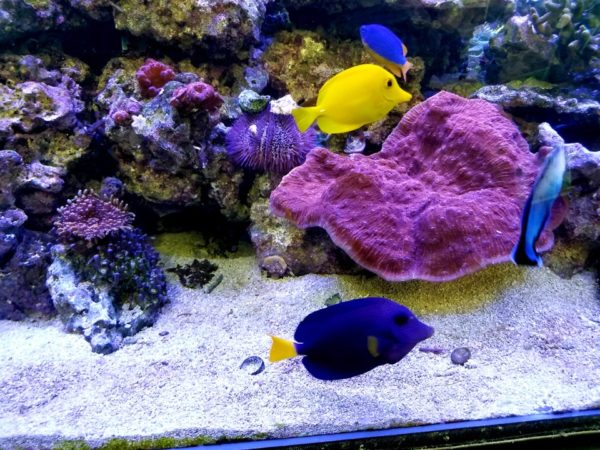
- Wrasses and chromis
- Cardinals
- Clownfish
- Large angels
- Frogspawn Corals
- Blue Tang
Bad Tank Mates For Purple Tang
The following is the list of some bad tank mates for your purple tang:
- Acanthurus
- Bristletooth tangs
- Zebrasoma
Breeding Purple Tang
Breeding purple tangs in imprisonment are extraordinary and notoriously hard. In addition, purple tangs are contentious and territorial around other tangs, so it is extremely tough to keep in the same tank, not just as a couple.
In expansion, it is nearly unthinkable to deduce the sex of the purple tang by just glancing at them. Therefore, for these intentions, maximum fish lovers have not put any effort into breeding these fish species.
Purple Tang Breeding Level
- Hard
Purple Tang Sexual Dimorphism?
To distinguish between male and female purple tang, we see the size of purple tang. For maximum breed, there are no sexual disparities observed. Still, for the purple tang, you would observe that the male purple tang would always be bigger than the female purple tang, and you would also notice it changing the color at the same time of the breeding process.
Purple Tang Common Diseases And Their Treatment
Generally, Purple tangs are not sensitive to illnesses or circumstances than other fish. Nonetheless, purple tangs always tour from one individual to another before arriving at their ultimate home so that they can experience various distinct bacteria and microbes.
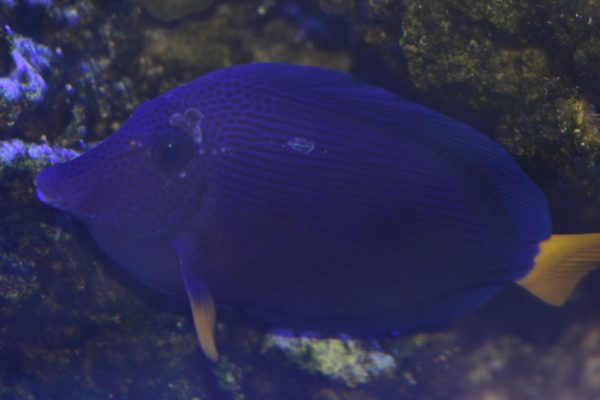
In expansion, shifting from a dealer to a home aquarium could be extremely annoying for your purple tang. Therefore, to assure that your fish is safe and happy in its modern residence, it is very crucial to accommodating it deliberately.
Once you are done with the accommodation process, you are required to keep your purple tang in a quarantine aquarium for some weeks to assure that your fish is not housing any disorders.
This would provide your purple tang with an opportunity to comfort and sleep and ensure that it would not transfer any bacteria or infections to any other fish.
Facts About Purple Tang
- Purple tang likes to feed on algae and might eradicate it if that is not adequately stored.
- You would be able to recognize some factors of bullying in them for their breeds. This is exceptionally so with adult purple tangs. When you add new fish, they are inclined to be anxious about them.
- You would be able to add other fish to the main tank of purple tang after shifting the gravel in the aquarium. This provides their fried a spot to conceal while confusing the old ones.
- Sometimes it could happen that your purple tang would not feed as they are told to store fat inside their bodies. It could keep them getting on rightful without having anything. If you notice this, you are not required to be worried.
- Generally, the purple range is healthy, and you would be able to maintain this if you fulfilled all the tank requirements.
Is Purple Tang Right For You?
A purple tang is a nice option for everyone, whether a newcomer or a progressed saltwater fish keeper. In addition, a purple tang is an outstanding option for reef aquariums as, aside from periodically jerking into or overthrowing gravel or coral configurations because of their high-spirited swimming, they would not be able to harm coral or leeches.
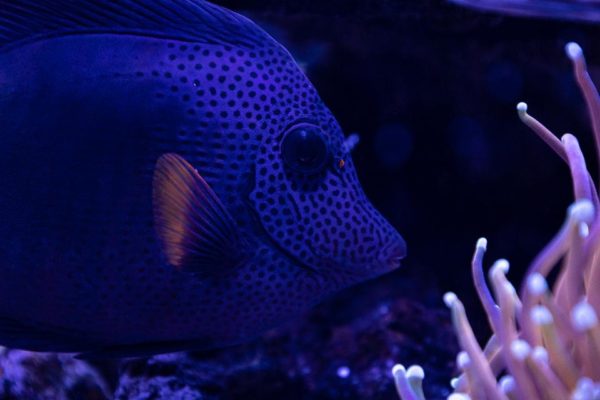
They are also considered peaceful with some other fish until that fish does not appear like them. Finally, purple tangs are considered a terrific option for anyone striving for a vibrant, enthusiastic expansion to the aquarium.
Frequently Asked Questions
Can You Keep A Yellow Tang With Your Purple Tang?
If you think of keeping a yellowtail tang with your purple tang, it would be a nice choice. You can keep both the tangs in the same tank at an identical time. But the size of the tank must be enough so that they can roam and swim around the aquarium.
At least an aquarium of 150 gallons would be fine. They will become contentious towards each other if you do not introduce them at a similar moment.
What Is The Lifespan Of A Purple Tang?
The purple tang’s body has a similar shape to that of a yellow tang. They have a sharp and strong protective backbone on both sides of their caudal fin. Its length is around 10 inches or more, and they generally live at least for 10 years or might be longer.
How Much Should You Nourish To Your Purple Tang?
You are required to provide dried seaweed. You could tie the seaweed to gravel or utilize a veggie hook to feed your purple tang. You are always advised to feed your purple tang at least thrice a week. Most importantly, you should avoid overfeeding as it might result in serious illness.
What Do You Nourish To Your Purple Tang?
You all must be aware that purple tang would eat anything you put into their tank. Even all the fish sometimes. Therefore, it is always recommended to provide them with a reasonable variety diet. For example, their diet might include music shrimp, Japanese nori, frozen brine, and fish and eggs.
Conclusion
Purple tangs look incredible if you keep them in an aquarium. Nevertheless, they are not susceptible to keep. In this article, we have explored and provided you with sufficient information on caring for purple tang.
They are community fish, so you would be able to keep them easily in a community purple tang tank or pond so they can grow and thrive adequately. Nonetheless, there is something about their behavior that makes you fascinated by the purple tang. Follow this fish care guide, and you will be able to provide them with your best care in the tank.
